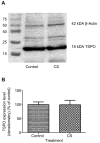18-kDa Translocator Protein Ligands Protect H9C2 Cardiomyocytes from Cigarette Smoke-induced Cell Death: In Vitro Study
- PMID: 32111753
- PMCID: PMC7157870
- DOI: 10.21873/invivo.11807
18-kDa Translocator Protein Ligands Protect H9C2 Cardiomyocytes from Cigarette Smoke-induced Cell Death: In Vitro Study
Abstract
Background: Cigarette smoke (CS) can induce cellular damage via alterations in 18 kDa translocator protein (TSPO)-related functions, leading to cardiovascular diseases. The current study focused on the possible protective effect of TSPO ligands against CS-induced damage to cardiac cells.
Materials and methods: H9C2 Cardiomyocyte cell line of rat origin was pre-treated with TSPO ligands. Cell death, TSPO binding, and TSPO protein expression levels were assessed following 30-min CS exposure with/without TSPO ligands.
Results: CS exposure of H9C2 cells significantly incensed cell death (by 26%, p<0.001). Pre-treatment with TSPO ligands at two concentrations prevented cell death. Neither CS nor ligands affected TSPO protein expression in H9C2 cells. CS led to increased cell death and reduced TSPO binding.
Conclusion: Reduced TSPO binding may have a role in CS-induced cell death, and TSPO ligand MGV-1 can prevent suppression of TSPO binding and corresponding cell death. These results may be relevant to treatment of cardiovascular diseases associated with CS.
Keywords: Cigarette smoke; H9C2; LDH; TSPO ligands; cardiomyocyte cell line.
Copyright© 2020, International Institute of Anticancer Research (Dr. George J. Delinasios), All rights reserved.
Conflict of interest statement
None declared.
Figures





References
-
- Veenman L, Bode J, Gaitner M, Caballero S, Pe'er Y, Zeno S, Kietz S, Kugler W, Lakomek M, Gavish M. Effects of 18-kDa translocator protein knockdown on gene expression of glutamate receptors, transporters, and metabolism, and on cell viability affected by glutamate. Pharmacogenet Genomics. 2012;22:606–619. doi: 10.1097/FPC.0b013e3283544531. - DOI - PubMed
MeSH terms
Substances
LinkOut - more resources
Full Text Sources
